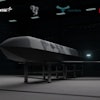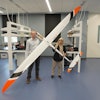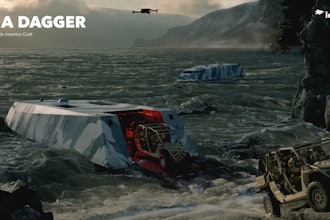DARPA Gives Air Force One Big Space Scope
This week, DARPA officially handed over the keys to its 90-ton Space Surveillance Telescope (SST) to the U.S. Air Force Space Command. The Air Force plans to move the telescope from its perch high atop a mountain at White Sands Missile Range in New Mexico to Australia, where it will operate it jointly with the Australian government.
DARPA built and designed the SST and according to the agency, it is redefining what telescopes are capable of, and could revolutionize space situational awareness. For example, SST uses the most steeply curved primary telescope mirror ever made. That allows it to collect more light to see images across a wider field of view.
The scope’s camera is also unique, because it has the first-ever curved chargecoupled device, which provides clear imagery across the wide field of view. It also has the fastest shutter speed in the world and can take thousands of pictures a night.
From its new home in Australia, SST will provide space situational awareness information from an area that is sparsely observed, but it will also provide surveillance data on transient events such as supernovas, as well as potentially hazardous near-Earth asteroids.
According to Darpa, before the SST, it was like looking at a few large objects through a drinking straw. Now, it’s a windshield view that can see 10,000 objects at a time, from 22,000 miles away, each as small as a softball.
Tap That Pipeline
Researchers at the University of British Columbia have developed a simple vibration test that could help oil and gas companies prevent pipeline spills.
The study found that pipeline imperfections could be identified by "tapping" the side of a pipe and then measuring the vibrations against computer models.
According to the researchers, using these small “tapping” machines that are attached to above-ground pipelines is a much faster and cheaper way to find cracks or rust patches than traditional imaging techniques.
The "tap test" theory actually stems from previous work with human bones. Turns out that the "tap test" was equally useful in finding areas of deficient bone density, which could be used to help identify conditions such as osteoporosis.
Thorvald, God of Robotic Agri-Tech
Thorvald is a mobile robot that they plan to use for new agri-tech experiments at the Lincoln Institute for Agri-food Technology (LIAT).
Thorvald was designed in collaboration with scientists at the Norwegian University of Life Sciences, but the development is far from over.
Researchers in Lincoln plan to first make the robot autonomous, so it can wander around fields and monitor crops and soils, moisture and fertility, and maybe even help farmers manage crops and precision weed control.
They also plan to deploy a new COSMOS sensor, or COsmic-ray Soil Moisture Observing System. A new state-of-the-art moisture sensor to help grid moisture patterns, which is the most difficult thing for farmers to measure.
Thorvald could be one of the key innovations for future farming, supporting research on everything from autonomous outdoor navigation and mapping, to crop yield prediction, in-field logistics and transportation.
This is Engineering By Design with David Mantey.






















